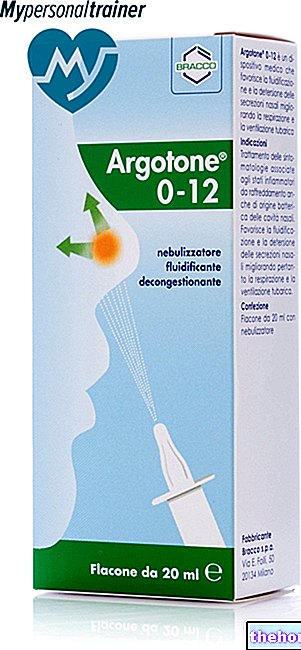Active ingredients: Tamsulosin
Lura 0.4 mg modified-release hard capsules
Indications Why is Lura used? What is it for?
Lura contains the active ingredient tamsulosin hydrochloride, which belongs to the category of medicines called alpha1 adrenergic receptor antagonists, which reduce the tension of the muscles of the prostate and urethra by facilitating the passage and elimination of urine.
Lura is used in men to treat lower urinary tract symptoms associated with an enlarged prostate (benign prostatic hyperplasia).
Contraindications When Lura should not be used
Don't take Lura
- if you are allergic to the active substance or any of the other ingredients of this medicine (listed in section 6). Hypersensitivity is also manifested by sudden local swelling of the soft parts of the body (eg throat or tongue), difficulty in breathing sometimes accompanied by itching (angioedema).
- if you have severe liver problems (severe liver failure);
- if you have ever had problems with lowering your blood pressure from sitting or lying down (orthostatic hypotension).
Precautions for use What you need to know before taking Lura
Talk to your doctor or pharmacist before taking Lura.
- As with other medicines of this type, in special cases with Lura you may have a reduction in your blood pressure and you may rarely pass out. At the first signs of low blood pressure (orthostatic hypotension) such as dizziness and weakness, you should sit or lie down until the symptoms disappear.
- Before starting therapy with Lura, your doctor will have to rule out the presence of other conditions that may cause you the same symptoms as enlarged prostate (benign prostatic hyperplasia) by means of specific tests.
- If you have severe kidney problems your doctor will use special caution as the medicine has not been studied in these people.
- If you have to undergo eye surgery for clouding of the lens (cataract), tell your doctor who is going to operate if you have taken or are taking Lura, as taking the medicine can increase surgical complications during and after surgery. . Your doctor can take the most appropriate precautions regarding the medicine. Ask your doctor if you need to postpone or temporarily stop treatment before undergoing eye surgery.
- It is possible that residues of the tablet will be found in the faeces.
Children and adolescents
Lura is not indicated for children. The safety and efficacy of Lura in children under 18 have not been established
Interactions Which drugs or foods can modify the effect of Lura
Tell your doctor or pharmacist if you are taking, have recently taken or might take any other medicines. In particular, be careful if you are taking any of the following medicines:
- cimetidine (a medicine to treat stomach acid)
- furosemide (diuretic) Diclofenac (for inflammation and pain) and warfarin (to thin the blood), as they can increase the rate of elimination of Lura.
- ketoconazole (for the treatment of fungal infections) or paroxetine (for depression), as they can increase the effect of Lura.
- other medicines belonging to the same class (alpha1-adrenoceptor antagonists), as they can cause a drop in blood pressure.
Warnings It is important to know that:
Pregnancy, breastfeeding and fertility
Lura is not suitable for female patients.
Abnormal ejaculation (ejaculation disorders) has been reported in the man. This means that seminal fluid does not leave the body via the urethra but enters the bladder (retrograde ejaculation) or that the ejaculation volume is reduced or absent (ejaculation failure).
Driving and using machines
Dizziness may occur after taking Lura, in which case you should not engage in activities that require attention.
Dose, Method and Time of Administration How to use Lura: Posology
Always take this medicine exactly as your doctor or pharmacist has told you. If in doubt, consult your doctor or pharmacist. The recommended dose is one capsule a day to be taken after breakfast or the first meal of the day.
The capsule must be swallowed whole and must not be crushed or chewed as this could interfere with the modified release of the active ingredient.
Use in children and adolescents
Lura is not indicated for children and adolescents under 18 years of age.
If you forget about taking Lura
Do not take a double dose to make up for a forgotten capsule.
If you have any further questions on the use of this medicine, ask your doctor or pharmacist.
Overdose What to do if you have taken too much Lura
If you have taken more Lura than you should, you may have severe drops in your blood pressure which have been observed at different overdose levels.
In case of accidental ingestion / intake of an excessive dose of Lura, notify your doctor immediately or go to the nearest hospital.
Side Effects What are the side effects of Lura
Like all medicines, this medicine can cause side effects, although not everybody gets them.
The following side effects have been observed:
Common side effects (may affect up to 1 in 10 people)
- dizziness
- ejaculation disorders
Uncommon side effects (may affect up to 1 in 100 people)
- headache (headache)
- noticeable and frequent heartbeat (palpitations)
- decrease in blood pressure when switching from sitting or lying down to standing (orthostatic hypopotension)
- runny and stuffy nose (rhinitis)
- constipation, diarrhea, nausea, vomiting
- rash, itching, hives
- weakness (asthenia)
Rare side effects (may affect up to 1 in 1000 people)
fainting (syncope)
sudden swelling of the soft parts of the body (e.g. neck and tongue), difficulty breathing with or without itching and redness of the skin (angioedema)
Very rare side effects (may affect up to 1 in 10,000 people)
- skin rash, inflammation, blistering of the skin and / or lips, eyes, mouth, nostrils or genitals (Steven-Johnson syndrome)
- prolonged and painful penile erection (priapism)
Undesirable effects with frequency not known (frequency cannot be estimated from the available data):
- blurred vision, visual impairment
- nosebleed (epistaxis)
- dry mouth
- severe skin rashes (erythema multiforme, exfoliative dermatitis)
- ejaculation disorder, seminal fluid in the bladder (retrograde ejaculation), ejaculation failure.
- abnormal heart rhythm (atrial fibrillation, arrhythmia, tachycardia)
- difficulty in breathing (dyspnoea).
Surgical complications (small pupil syndrome, known as "Intraoperative Flag Iris Syndrome" - IFIS have been observed and associated with Lura treatment during eye surgery due to lens opacity (cataracts). and precautions ").
Reporting of side effects
If you get any side effects, talk to your doctor or pharmacist. This includes any possible side effects not listed in this leaflet. You can also report side effects directly via the national reporting system at www.agenziafarmaco.it/it/responsabili. By reporting side effects you can help provide more information on the safety of this medicine.
Expiry and Retention
Keep this medicine out of the sight and reach of children.
Store at a temperature not exceeding 30 ° C.
Do not use this medicine after the expiry date which is stated on the carton after "expiry". The expiry date refers to the last day of that month.
Do not throw any medicines via wastewater or household waste. Ask your pharmacist how to throw away medicines you no longer use. This will help protect the environment.
Other Information
What Lura contains
The active ingredient is tamsulosin hydrochloride: 1 capsule contains 0.4 mg of tamsulosin hydrochloride.
The other ingredients are: microcrystalline cellulose, methacrylic acid - ethyl acrylate copolymer (1: 1), polysorbate 80, sodium lauryl sulfate, triacetin, talc, calcium stearate. The hard capsule consists of: gelatin, titanium dioxide (E 171), indigo carmine (E 132), yellow iron oxide (E 172), red iron oxide (E 172), black iron oxide (E 172).
Description of what Lura looks like and contents of the package
Modified-release capsule, hard - Box of 20 capsules in blister packs.
Source Package Leaflet: AIFA (Italian Medicines Agency). Content published in January 2016. The information present may not be up-to-date.
To have access to the most up-to-date version, it is advisable to access the AIFA (Italian Medicines Agency) website. Disclaimer and useful information.
01.0 NAME OF THE MEDICINAL PRODUCT
LURA 0.4 MG MODIFIED RELEASE CAPSULES
02.0 QUALITATIVE AND QUANTITATIVE COMPOSITION
Each modified-release capsule contains 0.4 mg of tamsulosin hydrochloride as the active ingredient.
Excipients: For the full list of excipients, see section 6.1.
03.0 PHARMACEUTICAL FORM
Modified-release capsule, hard
04.0 CLINICAL INFORMATION
04.1 Therapeutic indications
Lower Urinary Tract Symptoms (LUTS) associated with benign prostatic hyperplasia (BPH).
04.2 Posology and method of administration
Oral use
One capsule per day to be taken after breakfast or after the first meal of the day. The capsule should be swallowed whole.
The capsules should not be crushed or chewed as this could interfere with the modified release of the active ingredient. In case of renal impairment no dosage adjustment is required. In case of mild to moderate hepatic insufficiency, no dosage adjustment is required (see also section 4.3 Contraindications).
Pediatric population
There is no indication for specific use of LURA in children. The safety and efficacy of tamsulosin in children
04.3 Contraindications
Hypersensitivity to tamsulosin hydrochloride, including drug induced angioedema or to any of the excipients.
History of orthostatic hypotension.
Severe hepatic insufficiency.
04.4 Special warnings and appropriate precautions for use
As with other alpha 1 adrenoceptor antagonists, a reduction in blood pressure may occur in special cases during treatment with LURA, which rarely can lead to syncope. At the first signs of orthostatic hypotension (dizziness, weakness) the patient should sit or lie down until the symptoms disappear.
Before initiating therapy with LURA, the patient should be evaluated for the presence of other conditions that may cause the same symptoms as benign prostatic hyperplasia.
Rectal examination and, if necessary, determination of prostate specific antigen (PSA) should be performed before starting treatment and at regular intervals thereafter. The treatment of patients with severe renal impairment (creatinine clearance less than 10 ml / min) should be considered with caution, as the medicinal product has not been studied in these subjects. During cataract surgery some patients, previously treated or treated with drugs containing tamsulosin, have experienced the IFIS "Intraoperative Floppy Iris Syndrome" known as floppy iris. The appearance of this syndrome may increase surgical complications during and after surgery. Therefore it is recommended not to initiate treatment with tamsulosin in patients awaiting cataract surgery.
Anecdotal experiences have shown that stopping tamsulosin treatment 1 or 2 weeks prior to surgery may help. However, the benefit deriving from the suspension and the necessary interruption period have not yet been established. IFIS has also been found in patients who had stopped tamsulosin for a longer period prior to cataract surgery.
In the pre-operative evaluation phase, the physician must investigate whether the patient intended for surgery is or has been under treatment with tamsulosin in order to ensure appropriate measures for the management of IFIS during the operation.
Tamsulosin hydrochloride should not be administered in combination with strong inhibitors of CYP3A4 in patients with a poor metabolising CYP2D6 phenotype.
Tamsulosin hydrochloride should be used with caution in combination with strong and moderate inhibitors of CYP3A4 (see section 4.5).
It is possible that residues of the tablet will be found in the faeces.
04.5 Interactions with other medicinal products and other forms of interaction
Interaction studies have only been performed in adults.
No interactions were noted when tamsulosin was taken concomitantly with atenolol, enalapril, or nifedipine, or theophylline.
The concomitant use of cimetidine causes an increase in plasma tamsulosin levels, while furosemide lowers them; however, the plasma concentration levels of tamsulosin are within the therapeutic range and therefore no dosage adjustment is necessary.
In vitro diazepam, propranolol, trichlormethiazide, chlormadinone, amitriptyline, diclofenac, glibenclamide, simvastatin and warfarin do not change the free fraction of tamsulosin in human plasma. Tamsulosin does not modify the free fraction of diazepam, propranolol, trichlormethiazide and chlormadinone. In the studies in vitro with microsomal hepatic fractions (representative of the drug metabolization enzyme system linked to cytochrome P450) with amitriptyline, salbutamol, glibenclamide and finasteride no interactions at the level of hepatic metabolism were shown. However, diclofenac and warfarin may increase the rate of elimination of tamsulosin.
Concomitant administration of tamsulosin hydrochloride and strong CYP3A4 inhibitors may lead to increased exposure to tamsulosin hydrochloride. Concomitant administration with ketoconazole (a known strong inhibitor of CYP3A4) resulted in an increase in the AUC and C of tamsulosin hydrochloride by a factor of 2.8 and 2.2, respectively.
Tamsulosin hydrochloride should not be administered in combination with strong inhibitors of CYP3A4 in patients with a poor metabolising CYP2D6 phenotype.
Tamsulosin hydrochloride should be used with caution in combination with strong and moderate inhibitors of CYP3A4.
Concomitant administration of tamsulosin hydrochloride and paroxetine, a strong inhibitor of CYP2D6, resulted in an increase in tamsulosin Cmax and AUC by a factor of 1.3 and 1.6, respectively, but these increases are not considered clinically relevant. . The concomitant use of other alpha1 adrenoceptor antagonists may lead to hypotensive effects.
04.6 Pregnancy and breastfeeding
Not relevant as LURA is for use in male patients only.
Ejaculation disturbances have been observed in short- and long-term clinical studies with tamsulosin hydrochloride. Cases of ejaculation disturbances, retrograde ejaculation and inability to ejaculate have been reported in post-authorization studies.
04.7 Effects on ability to drive and use machines
No studies on the ability to drive and use machines have been performed. However, the patient should be aware of the possibility of vertigo occurring.
04.8 Undesirable effects
During cataract surgery, a variant of the small pupil syndrome known as "Intraoperative Flag Iris Syndrome" (IFIS) associated with tamsulosin therapy has been observed during the post-marketing surveillance period (see also paragraph 4.4).
Post-marketing experience: In addition to the adverse events listed above, atrial fibrillation, arrhythmia, tachycardia and dyspnoea have been reported in association with the use of tamsulosin. Since these spontaneously reported events come from post-marketing experience in all the world, their frequency and the role of tamsulosin in causing them cannot be determined with certainty.
04.9 Overdose
Symptoms
Overdose with tamsulosin hydrochloride can potentially lead to severe hypotensive effects.
Severe hypotensive effects were observed at different levels of overdose.
Treatment
In case of acute hypotension following an overdose, prompt action must be taken at the cardiovascular level. Blood pressure and heart rate can be restored to normal by making the patient lie down. If this is not enough, volume expanders and, if necessary, vasoconstrictive drugs can be used. Renal function should be monitored and general supportive measures applied. Dialysis is of little use as tamsulosin binds strongly to plasma proteins. Some measures such as emesis can be taken to prevent absorption.
In case of ingestion of large doses, gastric lavage can be useful and activated charcoal and an osmotic laxative, such as sodium sulfate, can be administered.
05.0 PHARMACOLOGICAL PROPERTIES
05.1 Pharmacodynamic properties
Pharmacotherapeutic group: alpha1 adrenoceptor antagonist.
ATC code: G04CA02 - Drugs for the exclusive treatment of prostate disorders - Tamsulosin.
Mechanism of action: tamsulosin binds selectively and competitively to postsynaptic alpha1 adrenoceptors, in particular alpha1A and alpha1D subtypes, which cause smooth muscle relaxation of the prostate and urethra.
Pharmacodynamic Effects: Tamsulosin 0.4 mg increases maximum urinary flow. Relieves obstruction by relaxing the smooth muscle in the prostate and urethra, thereby improving voiding symptoms. It also improves filling symptoms, in which bladder instability plays an important role.
These effects on filling and emptying symptoms are maintained during long-term therapy. The need for surgery or catheterization is significantly delayed.
Alpha1 adrenoceptor antagonists can reduce blood pressure by reducing peripheral resistance. No clinically significant reduction in blood pressure was observed during clinical trials with tamsulosin.
Pediatric population
A double-blind, randomized, placebo-controlled dose ranging study was conducted in children with neuropathic bladder. A total of 161 children (aged 2-16 years) were randomized and treated to 1 of 3 dose levels of tamsulosin (low [0.001 to 0.002 mg / kg], medium [0.002 to 0.004 mg / kg], and high [0.004 to 0.008 mg / kg]), or with placebo. The primary endpoint was the number of patients whose vanishing point detrusor pressure (detrusor leak point pressure, LPP) decreased until stabilization of hydronephrosis and hydroureter and change in urine volumes obtained from catheterization and number of urine leaks during catheterization, as recorded in catheterization diaries. There was no significant difference between the placebo group and any of the 3 tamsulosin groups for either the primary or secondary endpoints. No dose response was observed for any dose level.
05.2 Pharmacokinetic properties
Absorption
Tamsulosin is absorbed from the intestine and is almost completely bioavailable.
The absorption of tamsulosin hydrochloride is reduced by taking it close to meals.
Uniform absorption can be achieved if the patient always takes the product after the same meal.
Tamsulosin exhibits linear kinetics.
After a single dose of tamsulosin in fed state, plasma levels of tamsulosin peak in approximately 6 hours and, in steady state conditions, which are reached after 5 days of treatment, Cmax is approximately 2/3 higher than that achieved. after single dose.
This has been noted in elderly patients and it is reasonable to expect the same in younger patients.
There is considerable individual variation in plasma levels after both single and repeat dosing.
Distribution
In humans, tamsulosin is approximately 99% bound to plasma proteins and the volume of distribution is low (approximately 0.2 l / kg).
Biotransformation
Tamsulosin has a poor first pass effect as it is metabolized slowly.
Tamsulosin is present in plasma mainly in the form of unchanged active ingredient.
It is metabolized in the liver.
Virtually no induction of the microsomal liver enzyme system caused by tamsulosin was observed in the rat. In vitro results suggest that CYP3A4 and also CYP2D6 are involved in metabolism, with possible minor contributions to the metabolism of tamsulosin hydrochloride by other CYP isoenzymes. Inhibition of drug metabolising enzymes CYP3A4 and CYP2D6 may lead to increased exposure to tamsulosin hydrochloride (see sections 4.4 and 4.5).
None of the metabolites are more active than the original product.
Elimination
Tamsulosin and its metabolites are eliminated mainly in the urine and approximately 9% of the drug taken is eliminated in the unchanged form.
After a single 0.4 mg dose of tamsulosin in fed and steady state conditions, the elimination half-lives were measured at 10 and 13 hours, respectively.
05.3 Preclinical safety data
Single and repeat dose toxicity studies were performed in mice, rats and dogs. Reproduction studies in rats, carcinogenicity studies in mice and rats, genotoxicity studies were also considered. in vitro And in vivo.
The general toxicological profile as ascertained with the higher doses of tamsulosin is consistent with the known pharmacological activity of the alpha1 adrenoceptor antagonist drugs. In dogs, at very high doses, the electrocardiogram is changed. This response is considered not clinically relevant.
Tamsulosin did not show relevant genotoxic properties.
An increased incidence of proliferative changes in the udder of female rats and mice has been reported. These findings, which are likely mediated by hyperprolactinemia and occur only at high doses, are considered irrelevant.
06.0 PHARMACEUTICAL INFORMATION
06.1 Excipients
Microcrystalline cellulose, Methacrylic acid - ethyl acrylate copolymer (1: 1), Polysorbate 80, Sodium lauryl sulfate, Triacetin, Talc, Calcium stearate.
Hard capsule: gelatin, titanium dioxide (E 171), indigo carmine (E 132), yellow iron oxide (E 172), red iron oxide (E 172), black iron oxide (E 172).
06.2 Incompatibility
Not relevant.
06.3 Period of validity
2 years.
06.4 Special precautions for storage
Store at a temperature not exceeding 30 ° C.
06.5 Nature of the immediate packaging and contents of the package
PVC / Al heat-sealed blister in lithographed cardboard box, 20 capsules.
06.6 Instructions for use and handling
No special instructions.
Unused product and waste derived from this medicine must be disposed of in accordance with local legal requirements.
07.0 MARKETING AUTHORIZATION HOLDER
ECUPHARMA S.r.l
Via Mazzini 20
20123 Milan
08.0 MARKETING AUTHORIZATION NUMBER
LURA
"0.4 MG MODIFIED RELEASE CAPSULES - 20 CAPSULES AIC N. 036943013
09.0 DATE OF FIRST AUTHORIZATION OR RENEWAL OF THE AUTHORIZATION
July 4, 2006
April 2013




























